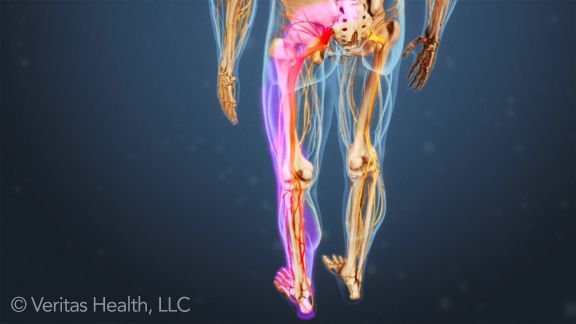For some people, sciatica pain can be severe and debilitating. For others, the sciatica symptoms might be infrequent and irritating, but have the potential to get worse.
Low back pain may be present along with the leg pain, but typically the leg pain is markedly more severe than the low back pain. Patients often describe their sciatica symptoms as electrical shocks running down the leg, or searing or burning pain.
See Leg Pain and Numbness: What Might These Symptoms Mean?
Common Sciatica Symptoms
Usually, sciatica affects only one side of the lower body and the pain radiates from the lower back to the back of the thigh and down the leg.
See Types of Sciatic Nerve Pain
Some combination of the following symptoms is most common:
- Constant pain in only one side of the buttock or leg, but rarely in both sides
- Pain that originates in the low back or buttock and continues along the path of the sciatic nerve—down the back of the thigh and into the lower leg and foot
- Pain that feels better when patients lie down or are walking, but worsens when standing or sitting
- Pain typically described as sharp or searing, rather than dull
- A “pins-and-needles” sensation, numbness or weakness, or a prickling sensation down the leg in some cases
- Weakness or numbness when moving the leg or foot
- Severe or shooting pain in one leg, making it difficult to stand up or walk
- Pain and other symptoms in the toes, depending on where the sciatic nerve is affected
- Lower back pain that, if experienced at all, is not as severe as leg pain
Symptoms may intensify during sudden movements, such as a sneeze or cough, or when changing positions, such as when moving from a sitting position to standing up.
Certain symptoms are unique depending on the underlying cause of the sciatica. For example, bending the body backward or walking more than a short distance often triggers symptoms when spinal stenosis is the cause. Bending the body forward may trigger symptoms if the cause is a lumbar herniated disc.
Sciatica Symptoms for Each Nerve Root
There are two nerve roots that exit the lumbar spine (L4 and L5) and three that exit the sacral segment (S1, S2, and S3).
All five nerves bundle together to form the sciatic nerve, and then branch out again within the leg to deliver motor and sensory functions to specific destinations in the leg and foot

